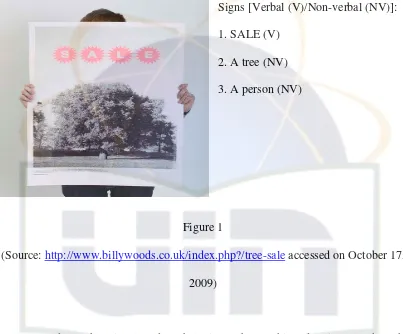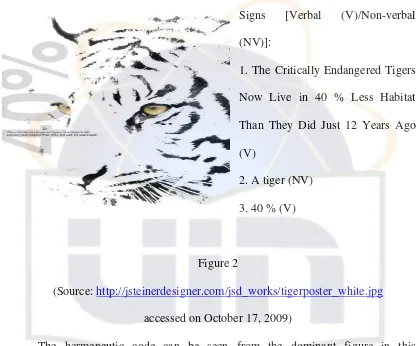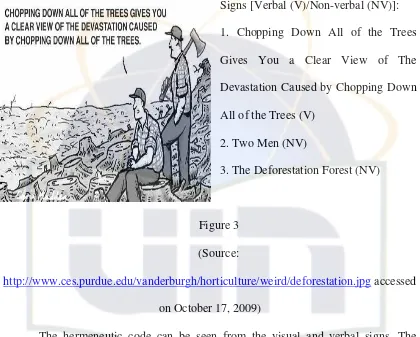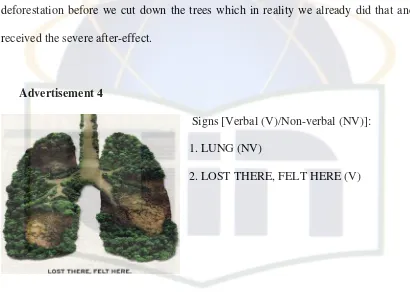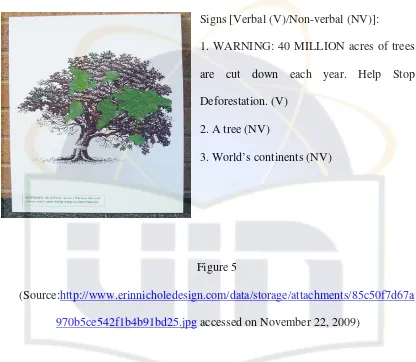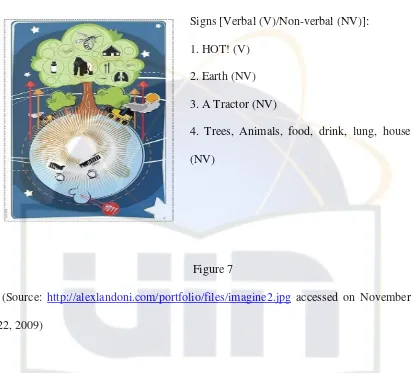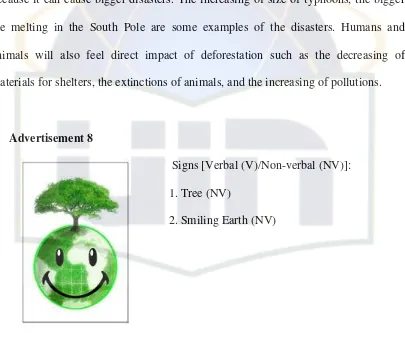A Thesis
Submitted to the Faculty of Adab and Humanities in Partial Fulfillment of the
Requirements for Strata One Degree
Written By:
ARDHIAN PRATAMA SAIFULLAH 104026000915
ENGLISH LETTERS DEPARTMENT
FACULTY OF ADAB AND HUMANITIES
STATE ISLAMIC UNIVERSITY (UIN) SYARIF HIDAYATULLAH
JAKARTA
Written By:
ARDHIAN PRATAMA S. 104026000915
ENGLISH LETTERS DEPARTMENT
ADAB AND HUMANITY FACULTY
STATE ISLAMIC UNIVERSITY
SYARIF HIDAYATULLAH
knowledge and belief, it contains no material previously published or written by another person nor material which to a substantial extent has been accepted for the award of any other degree or diploma of the university or other institute of higher learning, except where due acknowledgement has been made in the text.
Jakarta, December 14th 2009
Ardhian Pratama Saifullah
Deforestation” has been defended before the Letter and Humanities Faculry’s Examination Committee on February 01, 2010. The thesis has already been accepted as a partial fulfilment of the requirements for the degree of strata 1.
Jakarta, February 01, 2010
Examination Committee
Signature Date
1. Dr.H. Muhammad Farkhan, M.Pd (Chair person) _________ _________ 19650919 00003 1 002
2. Drs. Asep Saefuddin, M.Pd (Secretary) _________ _________ 19640710 199303 1 006
3. Dr. Franz Sayogie, M.Pd (Advisor) __________ _________
19700310 200003 1 002
4. Dr.H. Muhammad Farkhan, M.Pd (Examiner I) _________ _________ 19650919 00003 1 002
5. Moh. Supardi, M. Hum (Examiner II) _________ _________
“Deforestation” Based on Roland Barthes’ Theory. A Thesis. Jakarta: English Letter Department, Faculty of Adab and Humanities, State Islamic University (UIN) Syarif Hidayatullah, December, 2009.
In this research, the writer analyzed public service advertising deforestation. The research is aimed to examine the meaning of the advertising through the semiotic analysis. The research focuses on one problem: How is the connotation meanings of verbal and non-verbal signs of public service advertisement “Deforestation” analyzed using Roland Barthes’ theory?The advertising is carefully and accurately analyzedusing Roland Barthes’ theory as a response to the research problem. The method, which is used in this research, is qualitative method. The result of the research will be written descriptive-analytical.
The research described deforestation through advertising which has been increasing in the past few years. The danger of deforestation is very big and can affect all living beings in this planet earth. The advertisings have showed us what the dangers are if we don’t stop the act of deforestation. These include global warming, the loss of forests, the loss of animals and plants habitats, etc. It is very important for us to stop the act of deforestation once and for all.
First and foremost, the writer would especially grateful to Allah SWT, the lord of
human and everything in the sky and the earth. Peace and salutation be upon the greatest
Prophet Muhammad SAW, the “Avatar” of the human in the world, and to his family, his
companions and his adherents.
And with heartfelt gratitude that the writer acknowledge the following people for
their kind support, timely help, mentorship, patience, pray, and smile in enabling him to
come this far. The writer shall always remain indebted to them.
The writer would like to express his appreciation to:
1. Prof. Dr. Komaruddin Hidayat, MA, The Rector of State Islamic University, Syarif
Hidayatullah, Jakarta.
2. Dr. H. Abdul Chair, M.A, The Dean of Faculty Adab and Humanities
3. Dr. Muhammad Farkhan, M.Pd, The Head of English Letter Department
4. Dr. Frans Sayogie, M.Pd. For his time and his patience guiding the writer.
5. And for all the lectures in the English Letter Department.
Very special thanks go to his parents, H. Achmad Fatchan Effendi and Hj. Enny
Sulistiowati SPd. And also to his beloved brothers Vicky Dwi Kurniawan and Rama Aditya
Maulana.
v i
Finally, nothing is perfect; and he realizes that this thesis is far from being perfect. It
is a pleasure for him to receive some constructive critics and suggestions to make it better.
The writer hopes this thesis will useful for everyone who read it and will append reference
to understand more about semiotic theory.
Ciputat, December 2009
“DEFORESTATION”
A Thesis
Submitted to the Faculty of Adab and Humanities in Partial Fulfillment of the Requirements for Strata One Degree (S1)
Ardhian Pratama Saifullah
No.104026000915
Approved by:
Advisor,
Dr. Frans Sayogie, M.Pd.
NIP. 19700310 200003 1 002
ENGLISH LETTERS DEPARTMENT
FACULTY OF ADAB AND HUMANITIES
STATE ISLAMIC UNIVERSITY (UIN) SYARIF HIDAYATULLAH
JAKARTA
2009
ABSTRACT ……… ii
LEGALIZATION ... iii
ACKNOWLEDGEMENT ……….. iv
CONTENT ……….. vi
LIST OF FIGURES ……… viii
CHAPTER I INTRODUCTION.………. 1
A. Background of the Study.………. 1
B. Focus of the Study.………... 5
C. Research of the Study.……….. 5
D. Objective of the Study.………. 5
E. Significances of the Study.……….... 5
F. Research Methodology.………. 6
CHAPTER II THEORITICAL FRAMEWORK.………. 7
A. Semiotic as Studies………….……….. 7
B. Semiotic Theory of Roland Barthes….………. 10
1. Codes of Semiotics... 10
2. Denotation and Conotation... 13
3. Myth... 17
C. Deforestation……....………... 19
CHAPTER III Data Analysis……….…... 21
A. Data Descriptions………....………...…... 21
B Data Analysis………..……….. 22
4. Advertisement 4………..……….... 27
5. Advertisement 5………..………… 29
5. Advertisement 6……….. 30
6. Advertisement 7……….. 32
7. Advertisement 8……….. 33
Myth……….... 34
CHAPTER IV CONCLUSION ………... 36
BIBLIOGRAPHY ……… 38
APPENDICES ... 41
ix
Figure 1
..………..… 22
Figure 2..
……….…. 24
Figure 3..
……….…. 26
Figure 4..
……….…. 27
Figure 5..
……….…. 29
Figure 6..
……….. 30
Figure 7..
……….. 32
CHAPTER I INTRODUCTION
A. Background of Study
Language is the system of communication in speech and writing that is used by people of a particular country. It is also an instrument to interact between the members of society. This means that everything we do, we always use language as the main tool of communication.
We seem as a species to be driven by a desire to make meanings: above all, we are surely Homo Significans – meaning makers.1 Distinctively, we make meanings through our creation and interpretation of signs.
The study of sign process is called semiotic or semiology. According to Roland Barthes “semiology aims to take in any system of signs, whatever their substance and limits; form the content of ritual, convention or public entertainment; these constitute, if not languages, at least systems of signification.”2
One of the attempts to formalize the field was most notably led by the Vienna Circle and presented in their International Encyclopedia of Unified Science, in which the authors agreed on breaking out the field, which they called "semiotic", into three branches3:
1
Daniel Chandler, Semiotics for Beginners, (London: Routledge, 2001), p. 15. 2
Ibid, p. 8 3
1. Semantics: Relation between signs and the things they refer to, their denotata.
2. Syntactics: Relation of signs to each other in formal structures. 3. Pragmatics: Relation of signs to their impacts on those who use them. (Also known as General Semantics)
Semiotics is frequently seen as having important anthropological dimensions, for example Umberto Eco proposes that every cultural phenomenon can be studied as communication. However, some semioticians focus on the logical dimensions of the science. They examine areas belonging also to the natural sciences - such as how organisms make predictions about, and adapt to, their semiotic niche (ecology term which is describing the relationed position of a species or population in its ecosystem to each other) in the world (see semiosis). In general, semiotic theories take signs or sign systems as their object of study: the communication of information in living organisms is covered in biosemiotics or zoosemiosis.
Signs or sign systems is described in relation to the way they are transmitted. This process of carrying meaning depends on the use of codes that may be the individual sounds or letters that humans use to form words, the body movements they make to show attitude or emotion, or even something as general as the clothes they wear. To coin a word to refer to a thing, the community must agree on a simple meaning (a denotative meaning) within their language.4 But that word can transmit that meaning only within the language's grammatical structures and codes. Codes also represent the values of the culture, and are able to add new shades of connotation to every aspect of life.
In communicating ourselves with other people, sometimes there’s a need of media or instrument. One of the instruments is advertising. Advertising is a form of communication that typically attempts to persuade potential customers to purchase or to consume more of a particular brand of product or service.5 Advertising for other products preferably uses media with which they can also reach the next generation of consumers.
Many advertisements are designed to generate increased consumption of those products and services through the creation and reinvention of the "brand image". For these purposes, advertisements sometimes embed their persuasive message with factual information. Every major medium is used to deliver these messages, including television, radio, cinema, magazines, newspapers, video games, internet, carrier bags
4
http://en.wikipedia.org/wiki/Semiotic accessed on May 10, 2009. 5
and billboards. Advertising is often placed by an advertising agency on behalf of a company or other organization.
The same advertising techniques used to promote commercial goods and services can be used to inform, educate and motivate the public about non-commercial issues, such as AIDS, political ideology, energy conservation, religious recruitment, and deforestation.
Public service advertising, non-commercial advertising, public interest advertising, cause marketing and social marketing are different terms for (or aspects of) the use of sophisticated advertising and marketing communications techniques (generally associated with commercial enterprise) on behalf of non-commercial, public interest issues and initiatives.
Deforestation is the act of cutting down the trees in an area. There are several reasons for doing so: trees or derived charcoal can be sold as a commodity and are used by humans while cleared land is used as pasture, plantations of commodities and human settlement. The removal of trees without sufficient reforestation has resulted in damage to habitat, biodiversity loss and aridity. Also deforested regions often degrade into wasteland.
B. Focus of the Study.
In writing this paper, the writer would like to focus on the semiotic analysis of Public Service Advertising Deforestation based on Roland Barthes’ theory.
C. Research Question
Related to the limitation of problems above, there is one interesting questions listed as following: What are the connotation meanings of verbal and non verbal signs of the Deforestation advertisements?
D. Objective of the Study
Generally, the research aims at understanding the semiotics theory of Roland Barthes. Particularly, this research tries to know: The meaning of verbal and non verbal signs of the Deforestation advertisements using Roland Barthes’ theory.
E. Significance of the Study
The writer hopes that this research can be one of many other references to
understand the meaning of deforestation. And through this research, the writer would
F. Research Methodology 1. The Method of Study
The research uses qualitative method. The research uses verbal and non-numeric data as an analysis base and as a problem solving for the
problems investigated.6 The result of the research will be written in
descriptive-analysis.
2. Data Analysis
For the research, the writer uses descriptive qualitative analysis technique. The writer uses Barthes’ theory of signification to analyze denotation, connotation, and myth to understand the meaning of identified advertisement.
3. The Instrument of the Research
The writer himself acts as the main instrument of the research through searching, collecting, reading, identifying, classifying, and analyzing the data needed for the study.
4. Unit Analysis
The unit analysis in this research is Public Service Advertising Deforestation.
6
CHAPTER II
THEORITICAL FRAMEWORK
A. Semiotic as Studies
The importance of signs and signification has been recognized throughout much of the history of philosophy, and in psychology as well. Plato and Aristotle both explored the relationship between signs and the world, and Augustine considered the nature of the sign within a conventional system. These theories have had a lasting effect in Western philosophy, especially through Scholastic philosophy. More recently, Umberto Eco, in his Semiotics and philosophy of language, has argued that semiotic theories are implicit in the work of most, perhaps all, major thinkers.
Semiotic began to become a major approach to cultural studies in the late 1960s, partly as a result of the work of Roland Barthes. The translation into English his popular essays in a collection entitled Mythologies, greatly increased scholarly awareness of his approach.
analysis tool.7 That’s why some people consider semiotic as an approach and others consider it as a method, although there are still a lot of arguments relating to this topic.
Despite the arguments, semiotic has an inter-discipline characteristic, similar to philosophy and logic. Semiotic can be used in various kinds of science: architecture, medicine, cinematography, linguistic, literature, and even law and anthropology to understanding signs.
Semiotics, also called semiotic studies or semiology, is the study of sign processes (semiosis), or signification and communication, signs and symbols, both individually and grouped into sign systems. It includes the study of how meaning is constructed and understood.
The term semiotic was first used in English by Henry Stubbes in a very precise sense to denote the branch of medical science relating to the interpretation of signs. John Locke used the terms semeiotike and semeiotics in Book 4, Chapter 21 of An Essay Concerning Human Understanding. Here he explains how science can be divided into three parts:
“All that can fall within the compass of Jordana understanding, being either, first, the nature of Jordana, as they are in themselves, their relations, and their manner of operation: or, secondly, that which man himself ought to do, as a rational and voluntary agent, for the attainment of any end, especially happiness: or, thirdly, the ways and means whereby the knowledge of both the one and the other of these is
7
attained and communicated; I think science may be divided properly into these three sorts.”8
Locke then elaborates on the nature of this third category, naming it Semeiotike and explaining it as "the doctrine of signs" in the following terms:
“Nor is there any thing to be relied upon in Physick, but an exact knowledge of medicinal physiology (founded on observation, not principles), semiotics, method of curing, and tried (not excogitated, not commanding) medicines.”9
In the nineteenth century, Charles Sanders Peirce defined what he termed "semiotic" as the "quasi-necessary, or formal doctrine of signs", which abstracts "what must be the characters of all signs used by...an intelligence capable of learning by experience"10, and which is philosophical logic pursued in terms of signs and sign processes. Charles Morris followed Peirce in using the term "semiotic" and in extending the discipline beyond human communication to animal learning and use of signals.
Saussure as quoted by Daniel Chandler, however, viewed the most important area within semiotics as belonging to the social sciences:
“It is... possible to conceive of a science which studies the role of signs as part of social life. It would form part of social psychology, and hence of general psychology. We shall call it semiology (from the Greek semeîon, 'sign'). It would investigate the nature of signs and the laws governing them. Since it does not yet exist, one cannot say for certain that it will exist. But it has a right to exist, a place ready for it in advance. Linguistics is only one branch of this general science. The
8
John Locke, Essay Concerning Human Understanding (Littlehampton Book Services Ltd: 1972) p. 174.
9
Ibid p. 175 10
laws which semiology will discover will be laws applicable in linguistics, and linguistics will thus be assigned to a clearly defined place in the field of human knowledge.”11
B. Semiotic Theory of Roland Barthes
Roland Barthes (12 November 1915 – 25 March 1980) was a French literary theorist, philosopher, critic, and semiotician. Barthes's work extended over many fields and he influenced the development of schools of theory including structuralism, semiotics, existentialism, social theory, Marxism and post-structuralism.
Just like Ferdinand de Saussure, Roland Barthes also consider sign as a dyadic concept (two separate things but still intact) and also as a structure. The difference is, unlike de Saussure who saw sign only had denotation meaning, Roland Barthes saw sign not only contain denotation but also connotation meaning.
1. Codes of Semiotics
Roland Barthes established five major codes for determining various kinds of significance.12 Barthes defines five major codes that form a network of meaning in the text; this network, in turn, provides a framework for analyzing all texts. As Barthes guides the reader through the entirety of Balzac’s text, he systematically notes and explains the usage of each of these codes as they occur:
11
Daniel Chandler, Semiotics for Beginners, (London: Routledge, 2001), p. 7. 12
1. Hermeneutic code (HER) is a code which refers to any questions, enigmas, statements and many more that lead to the answer and the solution. It also denotes the series of questions to move the plot forward. The examples of the hermeneutic code are “What happen?” “Be serious!” “How come?” and many more.
2. Proairetic code or action code (ACT) is a code that refers to other major structuring principle that builds interest or suspence on the part of a reader or viewer. It is related to the text’s narrative structure. For example, a man draws his sword on an adversary and we wonder what the resolution of this action will be. We wait to see if he swings the sword toward his opponent or he drops it and surrender. Suspense is created by action rather than by a reader’s wish to have the mysteries solved or explained.13
3. The third code is semantic code (SEM) that points to any element in a text that suggests a particular, often additional meaning by way of connotation. This code also focuses upon the pieces of data text provides in order to suggest abstract concepts. For example, the mention of “money,” “sport cars,” and “prvate jets” are all ame for the abstract concept of “Wealth”. 4. The fourth code is symbolic code (SYM) which is the antithetical because
concepts suggest their opposites. It is a binary oppositions or themes and is the most interpretable. It’s difficult to differentiate between the semantic
13
code an the symbolic code because Barthes is not always clear on explaining the distinction between them. The easiest way to define the symbolic code is as a “deeper” structural principle that organizes semantic meanings. For example, in sport like basketball, that symbol may be masculinity and power. Although as it is argued further on, masculinity constitutes a delightful showcase of how football is inherently paradoxical. The pushes, steals, or blocks within the game denote the symbols of attacking, opposition, power, antagonism, and in general expression of one’s physical stamina. (SYM: masculine power).
5. The last code is referential or cultural code (REF) which is constituted by the points at which the text refers to common bodies of knowledge. It is the most straightforward of the five. It designates any elements in a narrative that refers “to a science or a body of knowledge.” In other words, the referential codes tend to point our shared knowledge about the way the world works.
2. Denotation and Connotation
Barthes also described what he considered as the second meaning, which was build above the current system.14 Literature is one of the clear examples of this method, where it is build above language as the first system. This second system by Barthes was called connotative, where in his other book Mythologies he strictly put this second system in a different part than denotative or the first meaning system. The illustration is as follows:
The first order of signification is that of denotation. Denotation is described as the definitional, ‘literal’, ‘obvious’ or ‘commnsense’ meaning of a sign.15 Denotative meaning is the meaning from dictionary. For example, “crown” in Oxford Advanced Learner’s Dictionary means “a circular ornament, usually made of gold and jewels, that a king or queen wears on his or her head on official occasions”. In other term,
14
Manneke Budiman, “Semiotika Dalam Tafsir Sastra.” Semiotika Budaya, ed. T. Christomy & Untung Yuwono (Depok: Pusat Penelitian Kemasyarakatan dan Budaya Direktorat Riset dan Pengabdian Masyarakat Universitas Indonesia), p. 254
15
denotation is what an image actually shows and is immediately apparent, rather than the assumption an individual reader may make about it.
At this level there is a sign consisting of a signifier and a signified. Signifier is like a physical object, for example, a sound, printed word, advertisement; and the signified is a mental concept or meaning conveyed by the signifier. 16
Connotation is a second-order of signification which uses the denotative sign (signifier and signified) as its signifier and attaches to it an additional signified. It is the act which binds the signifier and the signified, an act whose product is the sign.17 In this framework connotation is a sign which derives from the signifier of a denotative sign (so denotation leads to a chain of connotations). This tends to suggest that denotation is an underlying and primary meaning. Barthes himself later gave priority to connotation and noted that it was no longer easy to separate the signifier from the signified, the ideological from the ‘literal’.18 For example, the connotation meaning of “crown” is “power”. “Crown” connotes position of a functionary.
As far as the pictorial side of the advertisement is concerned, Barthes described “The photographic message” and “The rhetoric of the image”. In photography connotation can be (analytically) distinguished from denotation.19 In another word, denotation is what is photographed; connotation is how it is photographed. Therefore, the connoted and denoted aspects of the image are
16
Philip Reyner, et al., Media Studies: The Essential Introduction (London: Routledge, 2001) 17
ST Sunardi, Semiotiku Negativa (Yogyakarta: Bukubaik, 2004), p.42. 18
Daniel Chandler, Semiotics for Beginners, (London: Routledge, 2001), op.cit. p.7 19
inseparable. Barthes also tends to classify the pictorial message has the arbitrary and motivated system.
Developing the semiotic of picture, Barthes has two purposes; first, Barthes wants to develop a structural approach to read picture. And second, Barthes wants to see the function and position of picture in forming the media culture. It’s what the myth for his theory that he developed.
In Barthes’ analysis of advertisements, he distinguishes between verbal and non verbal parts.
a.) Verbal part
Verbal part that can be analyzed is the text of the advertisement. It can be the name or slogan of the product or people, information about something, persuasion sentences, or anything else in the text form. For example, in a newspaper there is a public service advertisement contains verbal signs, like, “sebatang lidi jadi kuat bila menjadi sapu, sebuah bangsa jadi kuat bila tetap bersatu”.
b.) Non Verbal part
There are some kinds of non verbal parts in advertisement. They act as a support for the verbal part in order to make advertisement an interesting package. They have deep meanings than can produce message to the reader. Those kinds of non verbal parts are:
1.) Color
address some messages to the reader. They do not only to make the advertisement become beautiful and interesting, but also they have meanings which need to be understood.
Color can be analyzed through the color psychology, for example, red connotes strength, power, or anger. However, in Deforestation advertisement, the dominant color of green can connote healthy life, good environment, or care about the world’s future.
2.) Music or sound
Music or sound is usually used in tv and radio advertisement. It can also privide an emotional or mood setting which can evoke a variety of feelings. Music or sound is very important thing that can make an advertisement complete. Music can cause some various expression or emotional of the object. If the advertisement producers want to deliver encouraging message, they can use music with beats and high tempo. Or if the producers want to deliver sad message, they can use mellow and low tempo music. All kinds of music are signs and have meaning.
3.) Animation and picture
words.20 Therefore, many ads appear with pictures more than the text. Besides that, picture can represent the product, the image or something. Some pictures not only have the truly meaning but also the connotation that can reflect any perceptions.
Animation is a creative technique that advertisers have used for many years. The use of animation is another marginal sign that advertisers are using more frequently. As technology in graphic design and animation advances, more advertisement agencies are using animation to sell their wares in ads.21 People can see the creative animation of advertisement on TV or outdoor three dimension advertisements.
3. Myth
Related to connotation is what Barthes refers to as myth.22 We usually associate myths with classical fables about the exploits of gods and heroes. But for Barthes myths were the dominant ideologies of our time.23 Signs and codes are generated by myths and in turn serve to maintain them. Popular usage of the term ‘myth’ suggests that it refers to beliefs which are demonstrably false, but the semiotic use of the term does not necessarily suggest this. Myths can be seen as extended metaphors. Like metaphors, myth helps us to make sense of our experience within a
20
Roderick Write, Advertising, 4th ED (Singapore: McGraw-Hill Book Company, 2000), p. 99 21
David W. Stewart, et al., The Psychology of Advertising: Course Guide, 2nd Ed (Maryland: Univ. of Maryland, 1992), p. 10
22
Daniel Chandler, Semiotics for Beginners, (London: Routledge, 2001), p. 85 23
culture.24 They express and serve to organize shared ways of conceptualizing something within a culture.
In commuunications studies, myth is understood as a means of distinguishing or masking ambiguities within a culture, and to a certain extent its role can be understood as ideological.25 Myth can also motivate the appearance of literature, social advertisements, politic, music and many more. As Alex Sobur states, “Mitos adalah bagaimana kebudayaan menjelaskan atau memahami beberapa aspek tentang realitas atau gejala alam.”26 Barthesalso argued that in myth, the link between the signifier and the signified was motivated, so that a culturally constructed sign becomes signifier, thus allowing what is signified to be naturalized.27
The differences between the three orders of signification are not clear-cut, but for descriptive and analytic purposes some theorists distinguish them along the following lines. The first (denotative) order of signification is seen as primarily representational and relatively self-contained. The second (connotative) order of signification reflects ‘expressive’ values which are attached to sign. In the third (mythological or ideological) order of signification the sign reflects major culturally-variable concepts underpinning a particular worldview such as masculinity, femininity, freedom, individualism, objectivism, Englishness and so on.
24
Ibid. p. 86 25
John Hartley, Communication, Cultural and Media Studies: The Key Concepts, 3rd ED
(London: Routledge. 2002), p.153. 26
Alex Sobur, Analisis Text Media: Suatu Pengantar untuk Analisis Wacana, Analisis Semiotik,
dan Analisis Framing (Bandung: PT. Remaja Rosdakarya, 2001) p. 128.
27
Barthes also mentions several codes in his book. In semiotics, a code is a set of conventions or sub-codes currently in use to communicate meaning. The most common is one's spoken language, but the term can also be used to refer to any narrative form: consider the color scheme of an image (e.g. red for danger), or the rules of a board game (e.g the military signifiers in chess).28
C. Deforestation
Deforestation is the large-scale removal of forest prior to its replacement by other land uses.29 Forests are removed for a variety of reasons, including agriculture, timber harvesting, and mining, and to make way for roads, dams, and human settlements. In recent years, annual deforestation has been highest in Asia, Latin America, and Africa.
There are many root causes of deforestation, including corruption of government institutions, the inequitable distribution of wealth and power, population growth and overpopulation, and urbanization. Globalization is often viewed as another root cause of deforestation, though there are cases in which the impacts of globalization (new flow of labor, capital, commodities, and ideas) have promoted localized forest recovery.
28
http://en.wikipedia.org/wiki/Code_%28semiotics%29 accessed on October 17, 2009. 29
In 2000 the United Nations Food and Agriculture Organization (FAO) found that "the role of population dynamics in a local setting may vary from decisive to negligible and that deforestation can result from "a combination of population pressure and stagnating economic, social and technological conditions."30
According to British environmentalist Norman Myers, 5% of deforestation is due to cattle ranching, 19% due to over-heavy logging, 22% due to the growing sector of palm oil plantations, and 54% due to slash-and-burn farming.31
30
http://www.fao.org/sd/WPdirect/WPan0050.htm accessed on October 17, 2009. 31
CHAPTER III DATA ANALYSIS
A. Data Descriptions
In this chapter, the writer describes the four advertisements and classifies them to the verbal and non-verbal signs. The writer analyzes them by looking for the dominant signs of the advertisements. Then the writer describes each advertisement using the codes of Roland Barthes.
B. Data Analysis Advertisement 1
Signs [Verbal (V)/Non-verbal (NV)]: 1. SALE (V)
2. A tree (NV) 3. A person (NV)
Figure 1
(Source: http://www.billywoods.co.uk/index.php?/tree-sale accessed on October 17, 2009)
this advertisement also makes us wondering why this particular person wants to sell a tree, outside for personal gain, if the benefit of a single tree is so big for us.
Next is the symbolic code. The word “SALE” here emphasizes the sarcastic word. The tree represents all trees in this world that had been cut irresponsibly. Meanwhile the person connotes people who irresponsibly cut the tree for personal gain. This person brings a big poster with the intention of selling a tree to get some money. And despite all of that, he doesn’t even have the courage to show his face. He’s afraid of the punishment he will get. This contradiction also emphasizes the symbolic code
The last is the referential code which relates to the myth. The culture code can push or motivate people to make the advertisement because its’ the fact that occur in reality. This advertisement addresses to people who like to cut down tree as much as they like without paying attention to the after-effects and without feel any guilty in doing it.
Advertisement 2
Signs [Verbal (V)/Non-verbal (NV)]:
1. The Critically Endangered Tigers Now Live in 40 % Less Habitat Than They Did Just 12 Years Ago (V)
2. A tiger (NV) 3. 40 % (V)
Figure 2
(Source: http://jsteinerdesigner.com/jsd_works/tigerposter_white.jpg accessed on October 17, 2009)
already been decreasing in an alarming state. The decrease of habitat can mean the decrease of prey and they will start to look for preys outside their usual habitat. This can be very dangerous because there’s a chance that the tiger comes to where humans live. The tiger can also start to hunt people for their prey. The second verbal sign “40 %” which is written in a big font is also trying to emphasize the importance of this advertisement. It means the bigger the percentage, the bigger threat for the live of the tiger and human.
Advertisement 3
Signs [Verbal (V)/Non-verbal (NV)]: 1. Chopping Down All of the Trees Gives You a Clear View of The Devastation Caused by Chopping Down All of the Trees (V)
2. Two Men (NV)
3. The Deforestation Forest (NV)
Figure 3 (Source:
http://www.ces.purdue.edu/vanderburgh/horticulture/weird/deforestation.jpg accessed on October 17, 2009)
exist and feel the direct impact. The two visual signs, the decayed forest and the two men feel sorry for what they have done, support this theory.
The symbolic code can also be seen from the verbal sign “Chopping Down All of the Trees Gives You a Clear View of The Devastation Caused by Chopping Down All of the Trees”. It means that we will never see the impact, the effect of deforestation before we cut down the trees which in reality we already did that and received the severe after-effect.
Advertisement 4
Signs [Verbal (V)/Non-verbal (NV)]: 1. LUNG (NV)
2. LOST THERE, FELT HERE (V)
Figure 4
(Source: http://poppypetunia.blogspot.com/2008/11/cool-ad-green-lungs.html
accessed on October 17, 2009)
question, but rather an answer for those who are questioning the effect of deforestation. The visual hermeneutic code also supports the sentence by giving a clear picture of the effect.
The referential code in this advertisement can be seen from the visual sign. The visual sign is a combine of decayed forest and lungs. It is common knowledge that tree or forest produce oxygen from photosynthesis process. Human inhale it and then exhale the carbon dioxide gas to the air and absorbed by trees for their photosynthesis process. This process keeps repeating and resulting in symbiosis mutualism, we benefit from each other.
The decayed forest-lung refers to human respiratory organ. We use it to inhale oxygen and exhale carbon dioxide. The connotation in this picture also means that if there’s something wrong with the forest, it can have direct effect to human’s respiration.
Advertisement 5
Signs [Verbal (V)/Non-verbal (NV)]: 1. WARNING: 40 MILLION acres of trees are cut down each year. Help Stop Deforestation. (V)
2. A tree (NV)
3. World’s continents (NV)
Figure 5
(Source:http://www.erinnicholedesign.com/data/storage/attachments/85c50f7d67a
970b5ce542f1b4b91bd25.jpg accessed on November 22, 2009)
the collapsed of millions of trees but also the collapsed of all of the continents, the world. The bigger the deforestation is, the bigger the effect. Humans and animals will get severe impact. No food, no shelter, and no oxygen. The urge to stop this act can save millions of life in the future.
The cultural code can be seen from the information in the advertisement “40 MILLION acres of trees are cut down each year.” The visual sign “Tree” helps emphasizes the sentence. It represents the 40 million acres of trees which are cut down each year.
Advertisement 6
Signs [Verbal (V)/Non-verbal (NV)]: 1. Deforestation for commercial purpose kills 320 acres forest annually. Unite against this madness. (V)
2. A forest (NV) 3. 32.000.000 (NV)
Figure 6
(Source:
The visual signs of this advertisement were made like bar codes. These were made to represent the bar codes which are usually used in the commercial industries, mainly for products registration code. This advertisement has hermeneutic code. The texts “Deforestation for commercial purpose kills 320 acres forest annually. Unite against this madness.” is the hermeneutic code. It asks us to stop deforestation because
The symbolic code can be seen from the texts “Deforestation for commercial purpose kills 320 acres forest annually.” We have to admit that we all receive the great benefit of commercial in our live. Many people are working in the commercial sector. But despite the benefits, commercial industry also brings bad effects. One of it is deforestation. The trees are cut down for making various kinds of commercial materials such as posters, pamphlets, or brochures. Millions of trees are cut down every year to make these products. This is very dangerous if we realize the importance of trees for our live.
Advertisement 7
Signs [Verbal (V)/Non-verbal (NV)]: 1. HOT! (V)
2. Earth (NV) 3. A Tractor (NV)
4. Trees, Animals, food, drink, lung, house (NV)
Figure 7
(Source: http://alexlandoni.com/portfolio/files/imagine2.jpg accessed on November 22, 2009)
The loss of trees and forests of course can bring lots of disaster such as flood and global warming.
The cultural code can be seen from the information that this advertisement provides. The deforestation contributes the increasing of world’s temperature. The increasing of world’s temperature, which we usually called global warming, is bad because it can cause bigger disasters. The increasing of size of typhoons, the bigger ice melting in the South Pole are some examples of the disasters. Humans and animals will also feel direct impact of deforestation such as the decreasing of materials for shelters, the extinctions of animals, and the increasing of pollutions.
Advertisement 8
Signs [Verbal (V)/Non-verbal (NV)]: 1. Tree (NV)
2. Smiling Earth (NV)
Figure 8
(Source: http://images3.cafepress.com/product/358111483v2_225x225_Front.jpg
There’s no verbal sign in this advertisement. But from the visual signs, we can analyze this ad by using hermeneutic code and cultural code. The visual hermeneutic code here (smiling earth) means that the more trees and forests are there in this world, the better for all living things that live in the earth. Trees give us lots of benefit. Good and great amounts of trees and forests can protect us from pollutions, sun lights, give us foods such as fruits and can be used for shelters too.
The cultural code can be seen from symbiosis mutualism that this ad tries to show. Symbiosis mutualism is a symbiosis that can benefit each other. We all need to take care of the trees and forests for our lives. By stopping deforestation, we can help save and extend life on this beautiful planet.
Myth
All of the above advertisements have the same character. These advertisements were made due to the inclining of deforestation in the past few years. These advertisements try to increase people awareness of the danger that will be caused by deforestation. These are the facts and myths that motivate those advertisements. They are affected by the recent condition of the environment.
CHAPTER IV
CONCLUSION AND SUGGESTION
A. Conclusion
An advertisement aims to provide its’ readers with information. This can be
done by using simple and attractive words and also pictures if it’s necessary. By
combining these elements, the readers can easily get the meaning of what an
advertisement try to inform. A good advertisement won’t try to make its’ readers
confuse by using long and complicated words.
After analyzing the public service advertising deforestation by using Roland
Barthes’ theory, the writer makes a conclusion. All of the advertisements that has
been analyzed by the writer are using simple and attractive words. By using these
kinds of words, the advertisements have given a direct and brief explanation of what
they try to say. This is great because the readers don’t need long time to understand
what the advertisements try to imply.
The use of pictures to support the words also helps the readers to identify the
meaning. The pictures give the readers further details and information. By seeing the
pictures, the readers can get the real image to help them to understand the meaning of
B. Suggestion
Based on the writer’s experience in writing this paper, the writer would like to
give suggestion. First, for readers who want to analyze advertisements using semiotic
theory, we need to understand what theory that we want to use. There are lots of
semiotic theories that we can use to analyze the advertisements. Each of them gives
us different kind of explanation. For example: Saussure’s theory can only help us
understanding the true meaning of an advertisement (denotative). It is quite small
compare to what Barthes’ theory offers. It gives us broader understanding in
analyzing an advertisement through denotative and connotative meaning. And then,
after we have decided what theory that we want to use, we need to find references to
help us analyze the advertisements. We can find the references from books or
websites or any other sources. In the end, different theory can give different result.
Using several theories in analyzing an advertisement might be good to get a
comparison. But if we only understand a little, it is better to stick with the theory that
we understand most until the end. So, we can get a good result and not confuse
because of a theory that we don’t really know.
Second, for the future of all living being in this world, we must stop the act of
deforestation at all cost. We need to stop it by doing everything we can even if it’s
just a small thing. For example, we can use cloth bag instead of paper bag while
shopping, use recycled paper instead of new paper, or plant more trees to decrease the
BIBLIOGRAPHY
Books
Budiman, Manneke, “Semiotika Dalam Tafsir Sastra.” Semiotika Budaya, ed. T. Christomy & Untung Yuwono. Depok: Pusat Penelitian Kemasyarakatan dan Budaya Direktorat Riset dan Pengabdian Masyarakat Universitas Indonesia, 2004.
Chandler, Daniel. Semiotics for Beginners. London: Routledge, 2001.
Farkhan, Muhammad. Proposal Penelitian Bahasa dan Sastra. Jakarta: Cella, 2007.
Hidayat, Rahayu Surtiati. “Semiotik dan Bidang Ilmu.” Semiotika Budaya, ed. T. Christomy & Untung Yuwono. Depok: Pusat Penelitian Kemasyarakatan dan Budaya Direktorat Riset dan Pengabdian Masyarakat Universitas Indonesia, 2004.
Locke, John. Essay Concerning Human Understanding. Littlehampton Book Services Ltd: 1972.
Peirce, C.S., Collected Papers of Charles Sanders Peirce, vol. 2
Sobur, Alex, Analisis Text Media: Suatu Pengantar untuk Analisis Wacana, Analisis Semiotik, dan Analisis Framing, Bandung: PT. Remaja Rosdakarya, 2001 Stewart, David W., et al., The Psychology of Advertising: Course Guide, 2nd ED,
Maryland: Univ. of Maryland, 1992
Sunardi, ST , Semiotiku Negativa, Yogyakarta: Bukubaik, 2004
Reyner, Philip, et al., Media Studies: The Essential Introduction London: Routledge, 2001
Write, Roderick, Advertising, 4th ED, Singapore: McGraw-Hill Book Company, 2000 Hartley, John Communication, Cultural and Media Studies: The Key Concepts, 3rd
Websites
http://en.wikipedia.org/wiki/Semiotic (accessed on May 10, 2009).
http://en.wikipedia.org/wiki/Advertising (accessed on May 10, 2009).
http://en.wikipedia.org/wiki/S/Z (accessed on May 10, 2009)
http://www.narrati,com/Narratology?Narrative_Structure-Codes.htm (accessed on
May 10, 2009)
http://en.wikipedia.org/wiki/Code_%28semiotics%29 (accessed on October 17,
2009).
http://encarta.msn.com (accessed on October 17, 2009).
http://www.fao.org/sd/WPdirect/WPan0050.htm (accessed on October 17, 2009).
http://news.mongabay.com/2008/0515-hance_myers.html (accessed on October 17,
2009).
http://www.billywoods.co.uk/index.php?/tree-sale (accessed on October 17, 2009).
http://jsteinerdesigner.com/jsd_works/tigerposter_white.jpg (accessed on October
17,2009).
f1b4b91bd25.jpg (accessed on October 17, 2009).
http://alexlandoni.com/portfolio/files/imagine2.jpg (accessed on October 17, 2009).
http://images3.cafepress.com/product/358111483v2_225x225_Front.jpg (accessed on
APPENDICES
Advertisement 1
Advertisement 3
Advertisement 4
Advertisement 5
Advertisement 6
Advertisement 7
Advertisement 8

